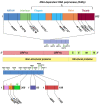Assessing Genomic Mutations in SARS-CoV-2: Potential Resistance to Antiviral Drugs in Viral Populations from Untreated COVID-19 Patients
- PMID: 38276171
- PMCID: PMC10821222
- DOI: 10.3390/microorganisms12010002
Assessing Genomic Mutations in SARS-CoV-2: Potential Resistance to Antiviral Drugs in Viral Populations from Untreated COVID-19 Patients
Abstract
Naturally occurring SARS-CoV-2 variants mutated in genomic regions targeted by antiviral drugs have not been extensively studied. This study investigated the potential of the RNA-dependent RNA polymerase (RdRp) complex subunits and non-structural protein (Nsp)5 of severe acute respiratory syndrome coronavirus-2 (SARS-CoV-2) to accumulate natural mutations that could affect the efficacy of antiviral drugs. To this aim, SARS-CoV-2 genomic sequences isolated from 4155 drug-naive individuals from southern Italy were analyzed using the Illumina MiSeq platform. Sequencing of the 4155 samples showed the following viral variant distribution: 71.2% Delta, 22.2% Omicron, and 6.4% Alpha. In the Nsp12 sequences, we found 84 amino acid substitutions. The most common one was P323L, detected in 3777/4155 (91%) samples, with 2906/3777 (69.9%) also showing the G671S substitution in combination. Additionally, we identified 28, 14, and 24 different amino acid substitutions in the Nsp5, Nsp7, and Nsp8 genomic regions, respectively. Of note, the V186F and A191V substitutions, affecting residues adjacent to the active site of Nsp5 (the target of the antiviral drug Paxlovid), were found in 157/4155 (3.8%) and 3/4155 (0.07%) samples, respectively. In conclusion, the RdRp complex subunits and the Nsp5 genomic region exhibit susceptibility to accumulating natural mutations. This susceptibility poses a potential risk to the efficacy of antiviral drugs, as these mutations may compromise the drug ability to inhibit viral replication.
Keywords: COVID-19; SARS-CoV-2; antiviral drug resistance; antiviral drugs; antiviral therapy; coronaviruses; natural variants; new generation sequencing; viral genomic mutation.
Conflict of interest statement
The authors declare no conflict of interest.
Figures




Similar articles
-
SARS-CoV-2 variants with NSP12 P323L/G671S mutations display enhanced virus replication in ferret upper airways and higher transmissibility.Cell Rep. 2023 Sep 26;42(9):113077. doi: 10.1016/j.celrep.2023.113077. Epub 2023 Sep 6. Cell Rep. 2023. PMID: 37676771 Free PMC article.
-
Genetic conservation of SARS-CoV-2 RNA replication complex in globally circulating isolates and recently emerged variants from humans and minks suggests minimal pre-existing resistance to remdesivir.Antiviral Res. 2021 Apr;188:105033. doi: 10.1016/j.antiviral.2021.105033. Epub 2021 Feb 5. Antiviral Res. 2021. PMID: 33549572 Free PMC article.
-
Biochemical characterization of naturally occurring mutations in SARS-CoV-2 RNA-dependent RNA polymerase.Protein Sci. 2024 Sep;33(9):e5103. doi: 10.1002/pro.5103. Protein Sci. 2024. PMID: 39145418 Free PMC article.
-
Antiviral Drug Discovery for the Treatment of COVID-19 Infections.Viruses. 2022 May 4;14(5):961. doi: 10.3390/v14050961. Viruses. 2022. PMID: 35632703 Free PMC article. Review.
-
Current Strategies of Antiviral Drug Discovery for COVID-19.Front Mol Biosci. 2021 May 13;8:671263. doi: 10.3389/fmolb.2021.671263. eCollection 2021. Front Mol Biosci. 2021. PMID: 34055887 Free PMC article. Review.
Cited by
-
Early mutational signatures and transmissibility of SARS-CoV-2 Gamma and Lambda variants in Chile.Sci Rep. 2024 Jul 11;14(1):16000. doi: 10.1038/s41598-024-66885-2. Sci Rep. 2024. PMID: 38987406 Free PMC article.
-
Simultaneously ultrasensitive and differential detection of SARS-CoV-2, adenovirus and influenza a virus using multiplex fluorescence lateral flow immunoassay.Front Immunol. 2025 May 9;16:1540676. doi: 10.3389/fimmu.2025.1540676. eCollection 2025. Front Immunol. 2025. PMID: 40416977 Free PMC article.
References
-
- Van Cleemput J., van Snippenberg W., Lambrechts L., Dendooven A., D’Onofrio V., Couck L., Trypsteen W., Vanrusselt J., Theuns S., Vereecke N., et al. Organ-specific genome diversity of replication-competent SARS-CoV-2. Nat. Commun. 2021;12:6612. doi: 10.1038/s41467-021-26884-7. Erratum in Nat. Commun. 2022, 13, 6247. - DOI - PMC - PubMed
LinkOut - more resources
Full Text Sources
Research Materials
Miscellaneous

